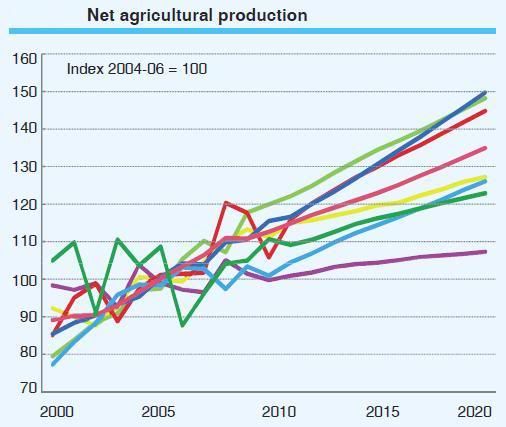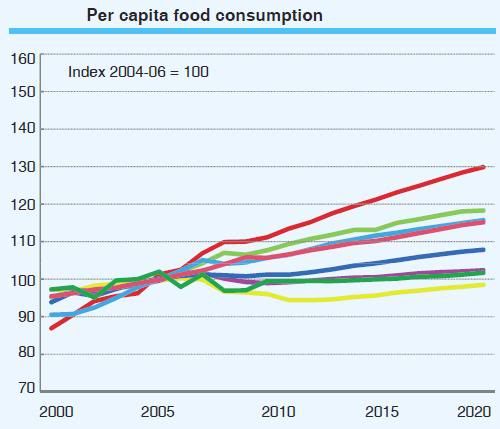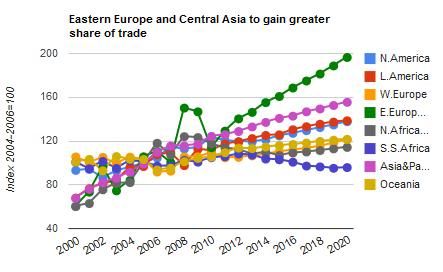KM: The following are excerpts from the very interesting OECD and FAO report, "Agricultural Outlook 2011-2020." Please note the following sentence:
Industrial agricultural methods are efficient and require little human labor, however, they rely too heavily upon fossil fuel use and they lack diversity. New production practices that are more diverse, regional, and resilient are desperately needed. Since policymakers aren't proactive, today's permaculture, eat local, transition, sustainable, and organic movements are very important and I expect them all to continue to gain momentum as more people become concerned about the challenges facing our food production.
This subject cannot be emphasized enough.
__________________________________
From the report:


source: OECD, FAO


source: OECD, FAO
And, next, the Guardian UK covers the report in this excerpt:

source: guardian
KM: I question the "strong Euro" part. And, I might add that in the U.S., exports will depend upon the biofuels policies and the strength of the dollar. Will mandated ethanol use back down at some point? Perhaps due to pressure over the moral issue of global high food prices?
source: OECD-FAO Agricultural Outlook 2011-2020
There are signs that production costs are rising and productivity growth is slowing. Energy related costs have risen significantly...One of my greatest concerns regarding food security, is that as the cost of producing food rises, the amount of food produced will lessen. Diminishing oil supplies and growing competition for the product mean that today's high production costs are headed higher. Add extreme weather events to the picture and crop failures will happen more frequently. Can the crop producers survive in a world with high input costs?
Industrial agricultural methods are efficient and require little human labor, however, they rely too heavily upon fossil fuel use and they lack diversity. New production practices that are more diverse, regional, and resilient are desperately needed. Since policymakers aren't proactive, today's permaculture, eat local, transition, sustainable, and organic movements are very important and I expect them all to continue to gain momentum as more people become concerned about the challenges facing our food production.
This subject cannot be emphasized enough.
From the report:


source: OECD, FAO
Higher commodity prices are a positive signal to a sector that has been experiencing declining prices expressed in real terms for many decades and are likely to stimulate the investments in improved productivity and increased output needed to meet the rising demands for food. However, supply response is conditioned by the relative cost of inputs while the incentives provided by higher international prices are not always passed through to producers due to high transactions costs or domestic policy interventions. In some key producing regions, exchange rate appreciation has also affected competitiveness of their agricultural sectors, limiting production responses.
There are signs that production costs are rising and productivity growth is slowing. Energy related costs have risen significantly, as have feed costs. Resource pressures, in particular those related to water and land, are also increasing. Land available for agriculture in many traditional supply areas is increasingly constrained and production must expand into less developed areas and into marginal lands with lower fertility and higher risk of adverse weather events. Substantial further investments in productivity enhancement are needed to ensure the sector can meet the rising demands of the future.
There are signs that production costs are rising and productivity growth is slowing. Energy related costs have risen significantly, as have feed costs. Resource pressures, in particular those related to water and land, are also increasing. Land available for agriculture in many traditional supply areas is increasingly constrained and production must expand into less developed areas and into marginal lands with lower fertility and higher risk of adverse weather events. Substantial further investments in productivity enhancement are needed to ensure the sector can meet the rising demands of the future.


source: OECD, FAO
And, next, the Guardian UK covers the report in this excerpt:

source: guardian
Trade in food is going to be pretty slow - growing by less than 2% as countries struggle to feed their own populations. The big countries will continue to dominate but the OECD predicts that exports of grain from the Russian Federation, Ukraine and Kazakhstan and other countries in Eastern Europe and Central Asia are anticipated to grow very rapidly. It also says that higher exports from Brazil are anticipated for virtually all its main commodities. In contrast, exports from the EU will be stagnant based on slow growth in production and a strong Euro.
KM: I question the "strong Euro" part. And, I might add that in the U.S., exports will depend upon the biofuels policies and the strength of the dollar. Will mandated ethanol use back down at some point? Perhaps due to pressure over the moral issue of global high food prices?
source: OECD-FAO Agricultural Outlook 2011-2020